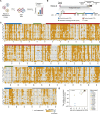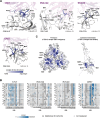This is a preprint.
Deep mutational scanning of rabies glycoprotein defines mutational constraint and antibody-escape mutations
- PMID: 39763725
- PMCID: PMC11702696
- DOI: 10.1101/2024.12.17.628970
Deep mutational scanning of rabies glycoprotein defines mutational constraint and antibody-escape mutations
Update in
-
Deep mutational scanning of rabies glycoprotein defines mutational constraint and antibody-escape mutations.Cell Host Microbe. 2025 Jun 11;33(6):988-1003.e10. doi: 10.1016/j.chom.2025.04.018. Epub 2025 May 20. Cell Host Microbe. 2025. PMID: 40398416
Abstract
Rabies virus causes nearly 60,000 human deaths annually. Antibodies that target the rabies glycoprotein (G) are being developed as post-exposure prophylactics, but mutations in G can render such antibodies ineffective. Here, we use pseudovirus deep mutational scanning to measure how all single amino-acid mutations to G affect cell entry and neutralization by a panel of antibodies. These measurements identify sites critical for rabies G's function, and define constrained regions that are attractive epitopes for clinical antibodies, including at the apex and base of the protein. We provide complete maps of escape mutations for eight monoclonal antibodies, including some in clinical use or development. Escape mutations for most antibodies are present in some natural rabies strains. Overall, this work provides comprehensive information on the functional and antigenic effects of G mutations that can help inform development of stabilized vaccine antigens and antibodies that are resilient to rabies genetic variation.
Conflict of interest statement
Competing interests JDB consults on topics related to viral evolution for Apriori Bio, Invivyd, the Vaccine Company, Pfizer, and Moderna. JDB, AKA, and CER are inventors on Fred Hutch licensed patents related to viral deep mutational scanning. N.P.K. is a cofounder, shareholder, paid consultant, and chair of the scientific advisory board of Icosavax, Inc. The King lab has received unrelated sponsored research agreements from Pfizer and GlaxoSmithKline.
Figures






References
-
- Singh R., Singh K.P., Cherian S., Saminathan M., Kapoor S., Manjunatha Reddy G.B., Panda S., and Dhama K. (2017). Rabies – epidemiology, pathogenesis, public health concerns and advances in diagnosis and control: a comprehensive review. Veterinary Quarterly 37, 212–251. 10.1080/01652176.2017.1343516. - DOI - PubMed
Publication types
Grants and funding
LinkOut - more resources
Full Text Sources
Miscellaneous
